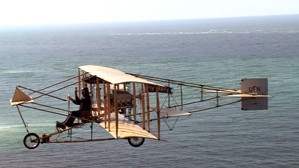A flying replica of the Curtiss pusher flown by Eugene Ely during his shipboard flights is now on display in the museum after performing in the Blue Angels Homecoming Airshow.
During the weekend of November 11-13, 2011, the past and present of U.S. naval aviation were on dramatic display in the skies over Naval Air Station (NAS) Pensacola. As always, the crowds at the Blue Angels Homecoming Air Show stared skyward in awe as the blue and gold painted F/A-18 Hornets looped and rolled and made high speed passes. Their thunderous roars were in stark contrast to another airplane that flew over the course of the weekend, one that represented naval aviation’s earliest roots and is now on temporary display in the National Naval Aviation Museum.
Not since the pioneering days of naval aviation had an anything like it buzzed over the Florida panhandle. Made of wood and fabric and powered by a pusher engine in which the engine is positioned behind the pilot with the propeller facing towards the rear of the aircraft, the replica Curtiss pusher commemorates the aircraft flown by civilian pilot Eugene Ely when he became the first aviator to land on the deck of a ship. The event, which occurred on a makeshift wooden deck erected on the armored cruiser Pennsylvania (ACR 4) anchored in San Franscisco Bay on January 18, 1911, helped spur the Navy to take the first steps towards integrating the airplane into naval operations.
Built and operated by Ely-Curtiss Aerial Exhibitions, the airplane made its maiden flight in New Market, Virginia, on October 8, 2010, with Bob Coolbaugh, a retired naval aviator and airline captain at the controls. Since that time, it has been featured at a host of Centennial of Naval Aviation events and even been hoisted onto the flight deck of George H.W. Bush (CVN 77), the latest in a storied list of aircraft carriers that were inspired by Ely’s demonstration of shipboard operations by an aircraft. Its flights in Pensacola were made possible by the Naval Aviation Museum Foundation, which coordinated with air station leadership and secured sponsorships.
